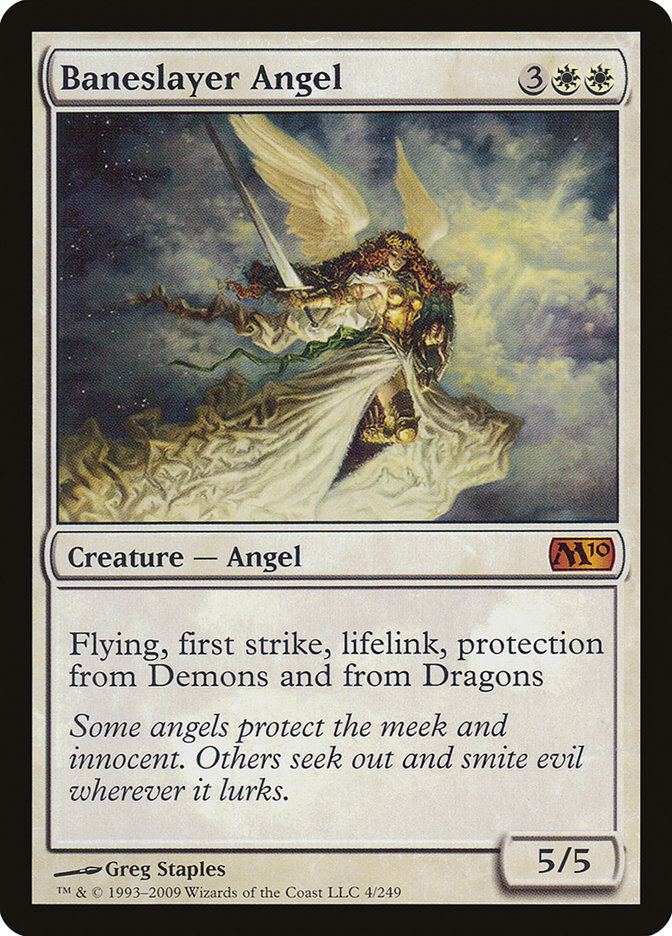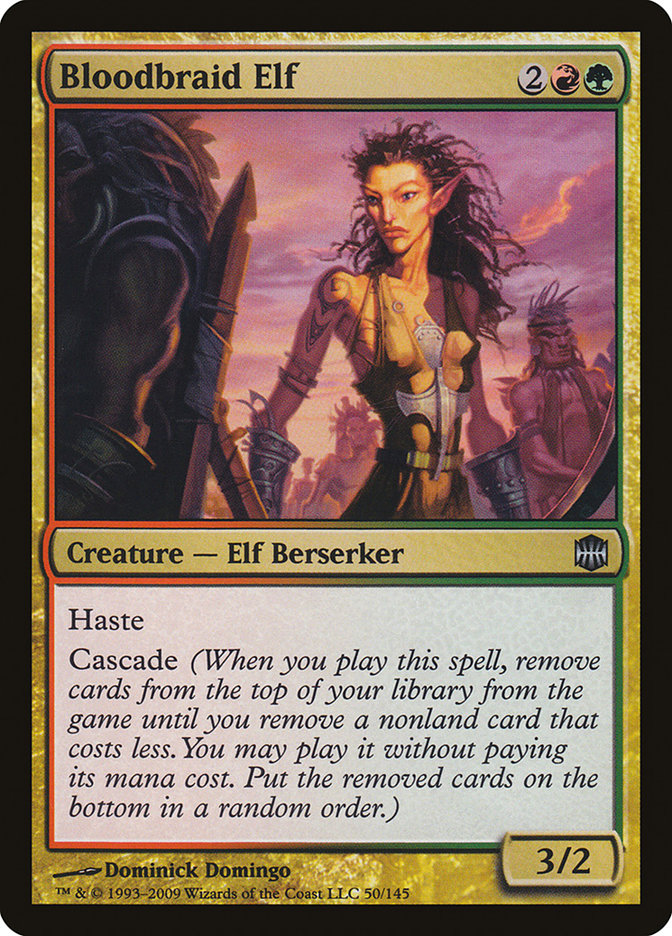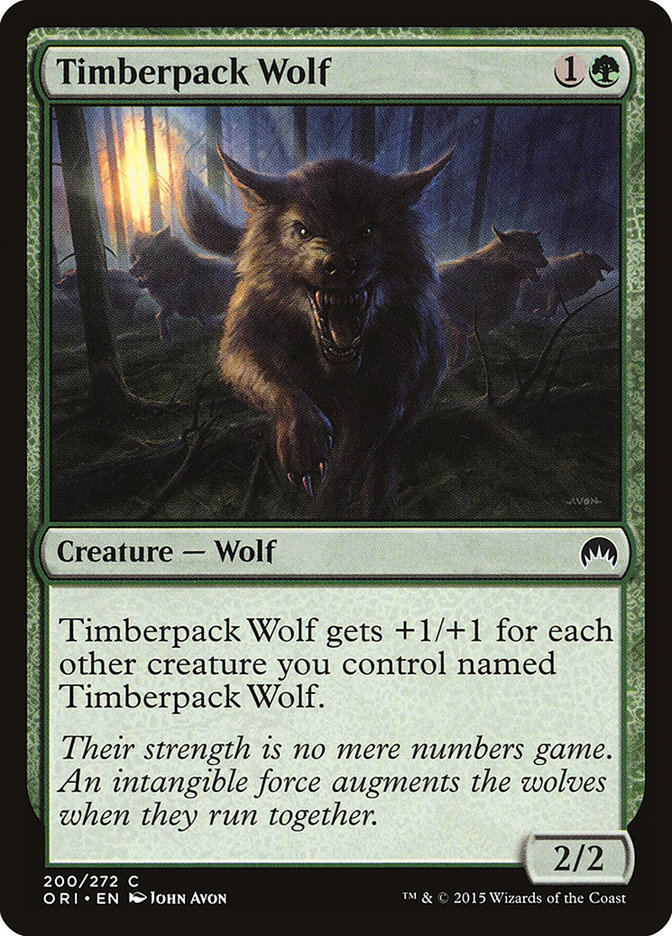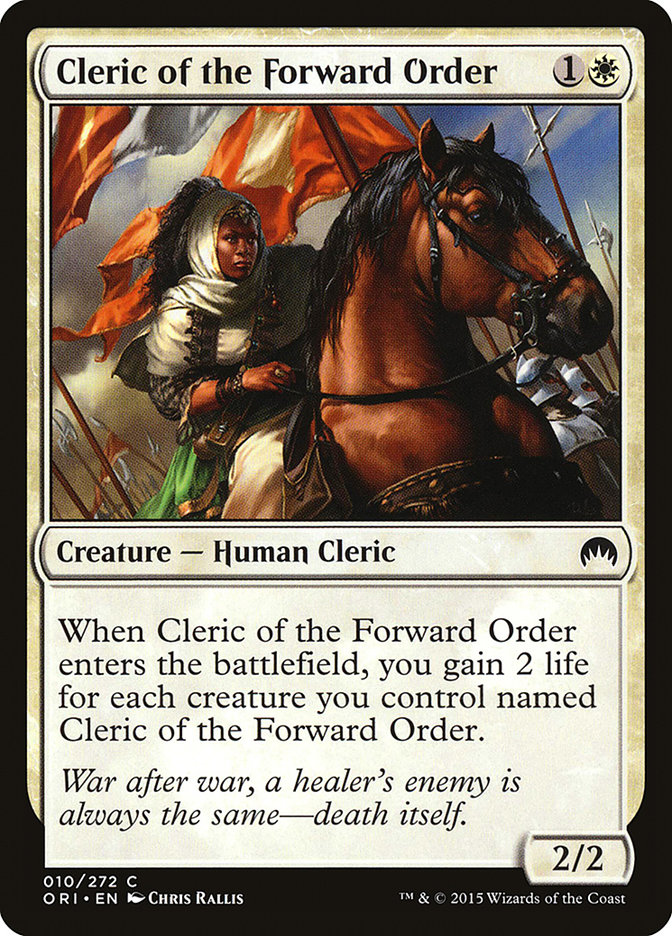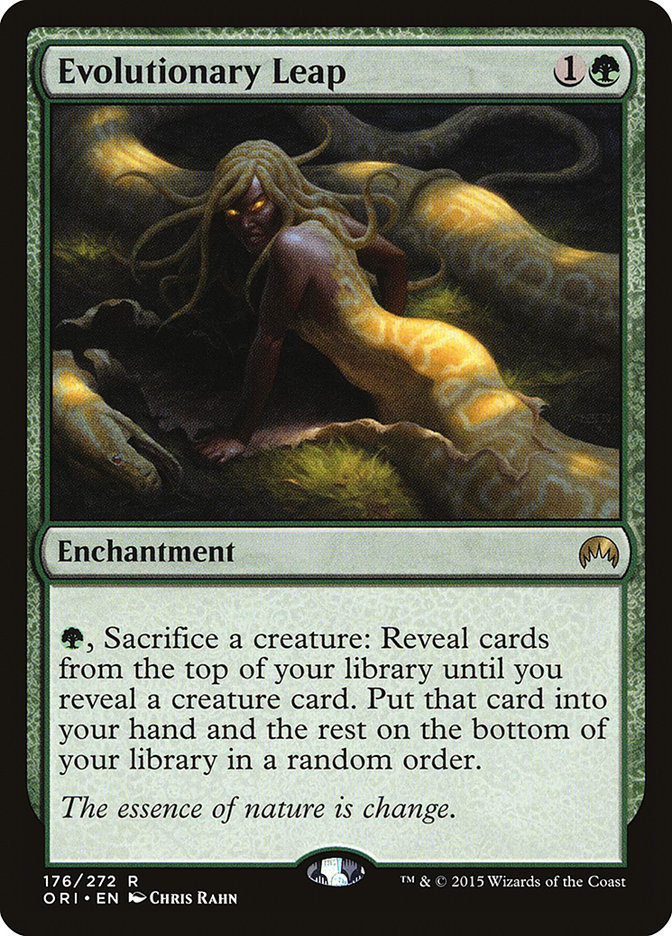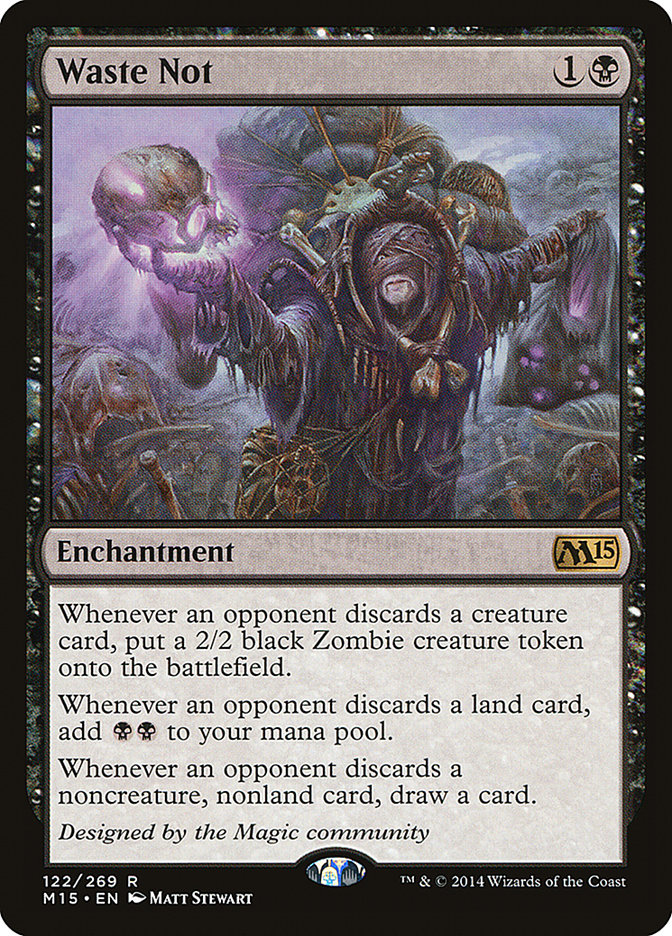
Magic’s always been about the big cards.
When you talk about Magic, you generally think about the most impactful cards of the past few years. Maybe a particular card or archetype flashes through your mind when you hear the word “overpowered” or “unbeatable.” These cards demand attention the moment they’re printed, and they don’t let go long after they’ve rotated out of the format in which they are the most relevant.
Today we’re not going to talk about one of those cards.
Timberpack Wolf? You mean I’m going to write about a card that’s not even new?
Well, sort of.
Timberpack Wolf was a pretty unique card when it was printed two years ago in Magic 2013, but it’s made a reappearance alongside a cycle of other cards that care about the card name. These cards don’t pass muster on nearly any baseline for Standard play, but they make excellent draft choices. Each has a respectable body for the cost and, if you drafted more than just a couple, you will likely get added value from playing multiples due to a nice effect, efficiency, or direct card advantage.
In its first printing, Timberpack Wolf entered a Constructed format filled with Thragtusk, Unburial Rites, and Sphinx’s Revelation. Needless to say, this little bear didn’t stand a chance to get noticed. Now, however, the format has chilled a bit, and almost anything goes. Standard is great right now, and just about every card with even a small amount of Constructed potential deserves a chance to try out for a 60-card deck.
Timberpack Wolf has potential mostly due to its efficiency. If the correct conditions are met, each of the four copies in your deck can attain Tarmogoyf-like efficiency. A set of Timberpack Wolves on the battlefield is lethal. Naturally, though, this little common is not nearly as efficient as a $150 mythic powerhouse. But how can we make it as likely as possible?
Jalira, Master Polymorphist was a card I’ve tried to build around since last year. Its overpriced ability, high casting cost, and non-legendary clause makes her a difficult creature to support, but Evolutionary Leap offers a similar effect with a lower cost and broader targeting. If we keep our creature count low, we can increase our chance to sacrifice something to find a Wolf. We have to figure out a non-creature way to make tokens, though.
Go on…
Creatures (14)
Lands (25)
Spells (21)

Creatures
Timberpack Wolf is a Grizzly Bears the vast majority of the time in Constructed. Although its power increases exponentially for every card you add to it, with six power for two, twelve power for three, and twenty power for four, there are some considerable probability hurdles you have to jump through to make this happen. After all, two-mana 5/5s don’t get printed too often these days.
To crunch some numbers with you, on the average seven-card hand, you have a 46% chance to have a Wolf in your opening hand. If you have the first copy, you will have slightly better than a 10% chance to have two Wolves in your opening hand. Thus, to draw two copies in your opening seven, you’re looking at around a 4.7% chance, or about once every twenty-one games. That means you are looking at just one occurrence in a seven-round tournament where you go to game three every time. And that’s all assuming they don’t have Thoughtseize, Ultimate Price, Wild Slash, Last Breath, Disperse, Bile Blight, or Courser of Kruphix, which can block either of the two.
But don’t worry; that’s not how we win.
Timberpack Wolf is a great roadblock; in today’s format of attacking on turn two, having a barrier for opponents to jump is something that a lot of decks reach for out of the sideboard. You’re not limited to having a 2/2, and the potential for growth makes the Wolf a great sandbag for the late game if it’s not relevant early. Costing two mana is a great feature for most cards, and Timberpack Wolf’s relevance, bolstered by the synergy of this deck, will make it smarter than the average bear.
Undead Servant features an excellent distinction from the Wolf; you need only cast one for it to be great. Because the Servant doesn’t care about you casting the other copies of itself, you can discard, sacrifice, or chump block any copies you have to get them in the bin. Then, every Servant you cast gets better, regardless of whether the other ones are still hanging around. Being on the Dark Deal plan fuels the graveyard, meaning you won’t likely cast this little number on-curve. Late in the game, four mana can buy you nine power across four creatures. Can somebody say Grave Titan?
Liliana, Heretical Healer is the reanimator of choice this time. She blocks well, is caught by Evolutionary Leap, and her flipside allows discard to occur, getting those aforementioned Servants in the yard without the hassle of spending mana. Any of the modes on her planeswalker side are relevant, really, and having multiple copies means she’s always going to be on the battlefield.
Nantuko Husk and Soul of Innistrad work side by side. The Husk offers a way to activate Liliana instantly and without cost, and it offers a way to get value out of Undead Servants. Remember, if the Servant dies while the ability is on the stack, you get a Zombie! Soul of Innistrad is something you can easily discard and use later, rebuying a whole pack of Wolves. If you can resolve it, which is likely when your opponent has few cards in hand to stop it thanks to the rest of your discard spells, you almost can’t lose.
Spells
Thoughtseize is a great card on its own, and the more support you can bring it for it the better it gets. People have been playing it with Waste Not in casual circles since the community-based enchantment was first printed, and this seems like a perfect pairing now. Waste Not provides card advantage, mana for bulky cards like Undead Servant, and Zombie tokens to sacrifice to Evolutionary Leap, the main reason for its inclusion. Add in that it can be semi-tutored for with the likes of Commune with the Gods and you’ve got a winner. Dark Deal goes right along with Waste Not and lets you dump those pesky Servants and Wolves into the yard to be reanimated by Liliana, Defiant Necromancer later. I’ve found that, in practice, three Dark Deal is much better than four, so we’re applying that principle here.
Bile Blight and Murderous Cut are the color’s best removal, and the efficiency of the Cut in particular is no joke. Because you have lots of cards in hand as a general rule thanks to Waste Not triggers and low-cost creatures, the efficiency of the Cut over something like Hero’s Downfall is critical here. Finally, Evolutionary Leap acts as a way to trigger Liliana, Heretical Healer, and it helps dig for one of the two main creatures of the deck. Because the creature spell count is low, you have a better than 50% chance on activation to hit one of these critical creatures.
Lands
Nothing much to note here, but having a heavily-black demand puts our mana at ease, as a single Urborg, Tomb of Yawgmoth can steady that need. A nonzero number of Forests are needed too, as there are probably turns where I’ll need to cast and activate Evolutionary Leap and, after finding it, casting another Timberpack Wolf before passing the turn.
This deck is a product of considerably goldfishing, not live combat, and it has done fine in that arena. It likely needs some help before I’d take it to an FNM, but it is pretty fun to play. The Waste Not/Dark Deal combo is pretty good as-is, and if Modern offers any indication, jamming that combo into a number of shells can give it some game. It likely needs some better game against heavy control and planeswalkers, but as-is, it’s certainly an entertaining option nonetheless.
I won’t give up on this one, but I’m always looking for something else. Besides, I did list two other cards alongside the Servant and Wolf, didn’t I?
I think Cleric of the Forward Order and Faerie Miscreant each belong in a different deck, but conventions be damned – we’re doing it.
Creatures (21)
- 4 Timberpack Wolf
- 4 Satyr Wayfinder
- 1 Den Protector
- 4 Jace, Vryn's Prodigy
- 4 Faerie Miscreant
- 4 Cleric of the Forward Order
Planeswalkers (1)
Lands (23)
Spells (15)

Without breaking down the obvious, we’re looking at a Return to the Ranks deck. Return to the Ranks, recently eclipsed by Rally the Ancestors, is a permanent resurrection spell with the disadvantage of only hitting creatures with a converted mana cost of two or less. Lucky for us, that’s every creature in this deck!
Alongside the twelve creatures that work with their kin, Jace, Vryn’s Prodigy is great at filling the graveyard with all sorts of exciting creatures to reanimate. As Jace, Telepath Unbound, he can cast Return to the Ranks again, perhaps even recovering another copy of himself for later and through him any of the deck’s other spells. Satyr Wayfinder fills the graveyard and helps you hit your mana in an unsupported shard. Den Protector can grab that one thing you didn’t plan to mill.
The spell list is straightforward, with Swift Reckoning as the removal of choice. Two mana is pretty efficient to kill any old creature that’s beating your face in, and to cast it at instant speed is a huge boon to prevent another pounding. Gather the Pack can grab up to two creatures for just two mana, and you might even be able to cast them immediately. Spell Mastery on both of these spells might seem unlikely to hit with just fifteen instants and sorceries, but the additional mill from Gather the Pack and Satyr Wayfinder these conditions will be met much more often. Return to the Ranks is our engine, but Ojutai’s Command also interacts with every creature in the deck, acting as removal, buffering against burn spells, and as a value spell to rebuy a dead creature. Gain four life and gain four more from a Cleric of the Forward Order resurrection? Yes please! Jace can recast Ojutai’s Command, too, effectively giving a creature flashback.
The biggest question with this deck and the Liliana-based list is the same: is it powerful enough? Sure, it’s cute, fun, and full of exciting interactions… but that doesn’t necessarily put hashes in the win column. Some testing will be necessary to test these hypotheses of decks.
Any of these creatures strike you as more powerful than their common rarity and complete obscurity would suggest? Maybe some casual Modern potential exists? Congregation at Dawn, perhaps?



